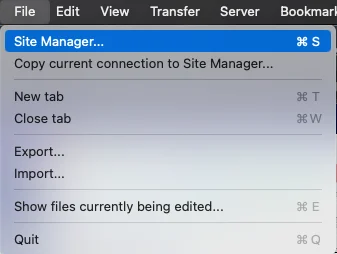Knowledge base article
Connecting to Serversaurus shared hosting via SFTP
View other technical support articles
Related articles
Connect via SFTP using SSH key authentication with FileZilla
Create a SSH key pair and configure your SSH key in cPanel
Other technical support articles
A beginners guide to email spoofing
Accessing your site before changing DNS
An introduction to email authentication
Basic WordPress security and site management
Check MySQL database table disk usage
Configure object cache with memcached and Litespeed Cache plugin
Configure spam filtering in cPanel
Connect via SFTP using SSH key authentication with FileZilla
Create a clone of your website
Create a SSH key pair and configure your SSH key in cPanel
Create a WordPress administrator via MySQL CLI
Create a WordPress administrator via phpMyAdmin
Create a WordPress cron task in cPanel
Disable automatic WordPress updates via wp-config.php
Download or restore individual files, directories or database backups with JetBackup
Enabling PHP extensions, Changing PHP Version and Setting PHP Options
Export or Import a MySQL database via CLI
Force HTTPS via .htaccess (cPanel)
Getting started with our DNS Manager
Getting Started with Virtual Machines
Go live with your WordPress staging website
Help! I need a backup of my cPanel-hosted website
Hide .html extension using .htaccess
How did my WordPress website get hacked? What do I do?
How to ensure website generated emails are delivered successfully
How to issue a Let’s Encrypt certificate
How to remove Site Software management
I can receive email but can’t send!
Install and configure Ghost blog in cPanel using Apache Reverse Proxy with mod_proxy
Introduction to LiteSpeed Cache
Manage DNS zones with the cPanel Zone Editor
Manual WordPress migrations in a nutshell
Migrate remote staging website to local hosting server
Migrate remote transactional website to local server
Migrating email from one POP/IMAP email account to another
My site and/or email service is down
Network Firewall (I can’t access my services on a non-standard port)
Optimising Wordfence firewall and security settings
Pointing your domain to Serversaurus
Pointing your domain to Squarespace with cPanel
Prevent website generated spam with CAPTCHA
Push updates from a staging to production website
Reconfigure production website to subdomain
Recover your hacked WordPress website
Remove Wordfence firewall block via MySQL CLI
Secure your WordPress installation
Setting up email on your iPhone
Subdomains for test sites & more
Unable to renew certificate: The Let’s Encrypt HTTP challenge failed
Understanding CloudLinux resource limits
Update a WordPress website to use a new domain name
Update your WordPress username via phpMyAdmin
Using Serversaurus’ nameservers but hosting your email elsewhere
This guide will teach you how to connect your SFTP client to Serversaurus hosting using key based authentication
Whether you're using FileZilla or another SFTP client, depending on the connection settings applied you may have issues connecting to your hosting server.
Serversaurus servers are built for optimum security, therefore to connect successfully you must ensure your SFTP client is using our recommended secure settings. This guide will walk you through configuring FileZilla however the settings can be used for any other SFTP client connection.
To follow this tutorial you need your cPanel login credentials. If you have forgotten your cPanel credentials, they were included in the original Welcome to Serversaurus or IMPORTANT: Hosting Documentation email which you should find in your inbox otherwise follow these instructions on how to update your cPanel password.
Open FileZilla and navigate to the File menu >> then select Site Manager.

Within the Site Manager window, please set the following:
Protocol: SFTP - SSH File Transfer Protocol
Host: This is your server hostname or server IP address.
Port: 22
Logon: Key file
User: Your cPanel username
Key file: Use Browse to select your SSH private key or otherwise add the path to your SSH private key. For MacOS users, your private SSH key is typically stored at /Users/USERNAME/.ssh/id_rsa (replace USERNAME with your device username). For Windows users, your private SSH key is typically stored at C:UsersUSERNAME.sshd_rsa
Once you've added those settings select Connect. You may receive a warning "Unknown host key" if this is the first time you've connected. In which case enable the checkbox "Always trust this host, add this key to the cache" and select OK.
You should now see your connection status has been marked successful.
Note: Our firewall will automatically block an IP address after three or more failed login attempts. If you're having connection issues, it's possible you have triggered the firewall to blacklist your IP address, in which case please visit our Status webpage to remove the block.
Published June 21, 2022. Last updated November 30, 2023.
Can't find what you're looking for?
"*" indicates required fields